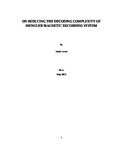ON REDUCING THE DECODING COMPLEXITY OF SHINGLED MAGNETIC RECORDING SYSTEM
| dc.contributor.supervisor | Zaki, Mohammed | |
| dc.contributor.author | Awad, Nadia | |
| dc.contributor.other | School of Engineering, Computing and Mathematics | en_US |
| dc.date.accessioned | 2013-08-05T10:57:58Z | |
| dc.date.available | 2013-08-05T10:57:58Z | |
| dc.date.issued | 2013 | |
| dc.identifier | 10320012 | en_US |
| dc.identifier.uri | http://hdl.handle.net/10026.1/1594 | |
| dc.description.abstract |
Shingled Magnetic Recording (SMR) has been recognised as one of the alternative technologies to achieve an areal density beyond the limit of the perpendicular recording technique, 1 Tb/in2, which has an advantage of extending the use of the conventional method media and read/write head. This work presents SMR system subject to both Inter Symbol Interference (ISI) and Inter Track Interference (ITI) and investigates different equalisation/detection techniques in order to reduce the complexity of this system. To investigate the ITI in shingled systems, one-track one-head system model has been extended into two-track one-head system model to have two interfering tracks. Consequently, six novel decoding techniques have been applied to the new system in order to find the Maximum Likelihood (ML) sequence. The decoding complexity of the six techniques has been investigated and then measured. The results show that the complexity is reduced by more than three times with 0.5 dB loss in performance. To measure this complexity practically, perpendicular recording system has been implemented in hardware. Hardware architectures are designed for that system with successful Quartus II fitter which are: Perpendicular Magnetic Recording (PMR) channel, digital filter equaliser with and without Additive White Gaussian Noise (AWGN) and ideal channel architectures. Two different hardware designs are implemented for Viterbi Algorithm (VA), however, Quartus II fitter for both of them was unsuccessful. It is found that, Simulink/Digital Signal Processing (DSP) Builder based designs are not efficient for complex algorithms and the eligible solution for such designs is writing Hardware Description Language (HDL) codes for those algorithms. | en_US |
| dc.description.sponsorship | The Iraqi Government | en_US |
| dc.language.iso | en | en_US |
| dc.publisher | University of Plymouth | en_US |
| dc.subject | Shingled Magnetic Recording | en_US |
| dc.subject | Inter-track Interference | en_US |
| dc.title | ON REDUCING THE DECODING COMPLEXITY OF SHINGLED MAGNETIC RECORDING SYSTEM | en_US |
| dc.type | Thesis | |
| plymouth.version | Full version | en_US |
| dc.identifier.doi | http://dx.doi.org/10.24382/4719 | |
| dc.identifier.doi | http://dx.doi.org/10.24382/4719 |
Files in this item
This item appears in the following Collection(s)
-
01 Research Theses Main Collection
Research Theses Main


